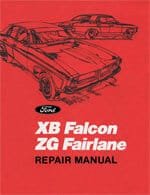XB Falcon Workshop Manual
The sleek and streamlined theme which began with the XA Falcon was continued on to the XB Falcon. Front disc brakes were fitted as standard for the first time on the Falcon, with the Futura upwards having power-assisted brakes. Reworking of the XA’s sleek lines to become the XB was clever in the use of a new bonnet and grille and new front and rear bumpers. The tail-lights had grown in size and were wrap-around units. Three of Ford Australia’s top stylists went to the US to develop the XA which, they said, found its ultimate expression in the XB. Rapidly climbing inflation meant that Falcon prices began at $3236, $216 more the then XA Falcon.
With the introduction of the XB Falcon, Ford passed another milestone, the production of two million vehicles in Australia. Fittingly it was a Fairmont which rolled off the assembly line as the official 2,000,000th vehicle. Unfortunately for Ford, by producing the2,000,000th vehicle on Remembrance Day its publicity thunder was stolen by the sacking of the Whitlam Government.
Models in the XB range included the 500, Futura, GT and Fairmont sedans, the hardtop, two wagons, the van and utility range and a Falcon and a Futura intended for use as taxis.
The XB was seen by many as the average car for the average driver. There must have been a lot of average drivers, for the XB outsold the headline grabbing XA by 68,156 units!
As part of Ford’s marketing, it introduced a ‘value for money’ program, which offered as standard on all models (except the GT), a range of items which would normally be offered as extras. There was a rise in price, but this, it was pointed out, was small compared to the value of the added features.
Ford commercials proved to be very adaptable as recreational vehicles. The XB Falcon 500 utility could be delivered as the Overnighter with a slide-on over-night camper to provide comfortable camping accommodation for two during holidays and a reliable workhorse during the working week. The standard XB van could be ordered as the Surf sider ready fitted with a hinged elevating roof and nylon sleeve to provide necessary headroom for the accommodation of two adults and one child. The Surferoo was very definitely aimed at the youth market. A basic Falcon 500 van was fitted with moulded fibreglass storage compartments, foam mattress, ice-box and fluorescent interior lighting.
Available as a four-door sedan or the two-door hardtop, the Falcon GT continued to be every small (and not so small), boys’ dream machine. It had stunning lines and a bold paint finish.
The EF II saw the introduction of dual airbags. The oddly shaped passenger bag protects not only the person in the left seat, but also a front-centre passenger in a bench seat model. Tickford continued the quad, round-head light treatment with its XR range of high performance Falcons.
Again a single colour was used across the entire front of the car and in the bumpers. The bumpers and body strips had Cherry Red inserts, except in red cars where they were black. The gills in the bonnet, which are reminiscent of those used in the 25th anniversary EB GT and the Sierra Cosworth – extract hot air. The EF model was the first Falcon which Tickford was involved with from its earliest design stages. Previously Tickford Vehicle Engineering had picked up a car midway through its development.
The Tickford XR interior featured full instrumentation, a driver-side airbag (as in all EF Falcons) and brightly coloured seats which featured good side and under thigh support. Power front windows were standard in an XR for the first time.
The Tickford modified 4-litre six cylinder engine in the XR6 was up rated to 164kW, only one kilowatt less than the standard 5-litre V8! So good was the six’s design that the torque graph was literally flat all the way from 2750rpm to3500rpm. The XR6’s exhaust valves were larger (42mm versus39mm) than the standard sixes, and they ran in stronger springs. The exhaust ports were reflowed as part of the design process. The camshaft profile gave greater lift and longer duration of all valves. The V8 engine on the Tickford XR86 didn’t receive as much modification as the six, but still had bulk grunt. Power peaked at170kW, pumped out at just 4500rpm. Maximum torque of 396Nm came in at 3000rpm. A larger cross section cold air intake snorkel was used and the split branch exhaust as fitted to the ED XR6 Sprint was installed.

